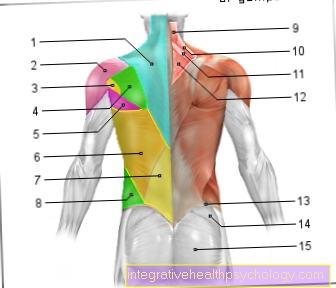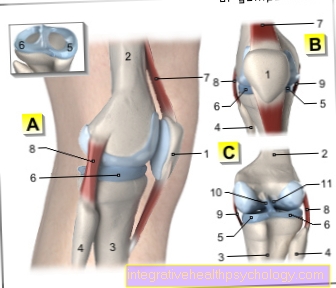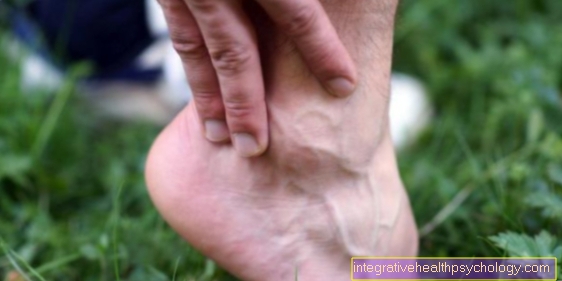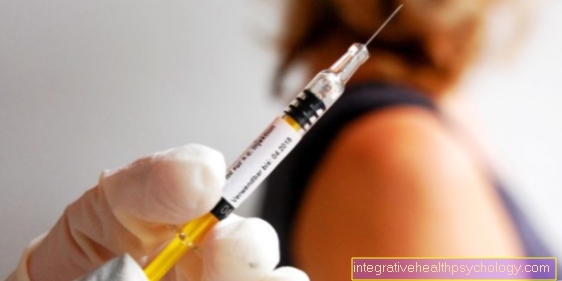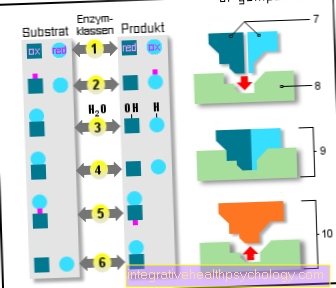abscess
introduction
An abscess is an encapsulated collection of pus in an unformed body cavity. This is caused by inflammatory melting of the tissue skin. The pus consists of:
- bacteria
- dead cells and
- Immune defense cells (white blood cells)
The inflammatory reaction is caused by various bacteria that are often part of the normal skin flora and penetrate the skin through injuries and cause inflammatory reactions there. Due to the accumulation of pus, the abscess exerts pressure on the surrounding tissue and can lead to pain.
Abscesses vary in size from small, barely visible, round knots to flat areas that can be as large as the palm of the hand. If an abscess forms on a hair root, it is called a boil, if several boils fuse together, it is called a carbuncle.
In principle, abscesses can develop anywhere:
- brain
- liver
- Anus (Anal abscess)
- Gums
- face
Most often, however, they occur in or under the skin, as this is usually the first to be confronted with potential pathogens. In contrast, empyema is an accumulation of pus in an already preformed body cavity. (e.g. paranasal sinuses)
Symptoms of an abscess
The superficial abscess shows typical skin reactions, as is usual with an inflammatory reaction, with reddening, swelling and overheating of the skin over the abscess. In some cases the collection of pus can also be seen as a white point / white area. Often there is also pain, which is especially aggravated by pressure (in the case of anal abscesses when sitting or when defecating). Depending on the size of the abscess, it can look almost exactly like a pimple.
Deeper abscesses can initially run completely symptom-free until they open up and the pathogen spreads in the body. Then typical clinical symptoms with fever and a general feeling of illness appear, after which one should consult a doctor at this point at the latest.
If the pathogens spread in the bloodstream, there is a risk of blood poisoning (sepsis), which is accompanied by a very severe general feeling of illness and a high fever. If left untreated, sepsis can lead to multiple organ failure and thus be fatal and is therefore a very serious disease that must be treated with antibiotics as quickly as possible. Because of this, an abscess should always be treated early.
Clear signs of urgent treatment are:
- fever
- Increase in size of the abscess
- significant redness and
- Pain in the abscess area
The terms "abscess" and "furuncle" are often used as synonyms. But there are some clear distinguishing features. Read our article on this: Abscess or boil
Itching of an abscess
The inflammatory reaction on the skin can cause redness and itching of the skin. In general, however, itching is not a key symptom of the abscess, but rather rare. Pain, swelling, tenderness and pus are described more frequently, as well as systemic symptoms such as fever, fatigue and headache and body aches.
Causes of an Abscess

The majority of abscesses develop without an obvious cause. As a rule, bacteria are the triggering factors for an abscess. In response, the body activates the immune system and the white blood cells fight the pathogens, which creates the pus. Finally, the body forms a capsule around the collection of pus to prevent the abscess from spreading any further in the body.
Often genera of Staphylococcus aureus isolated from the abscess. But also Streptococciwhich are part of the normal skin flora, tuberculosis bacteria or fungi can cause inflammatory reactions and thus abscesses.
The pathogens can penetrate the skin through the smallest injuries and lead to the formation of an abscess. But also
- Operations
- Foreign body or
- Syringes
can contribute to abscess formation through the penetration of pathogens into the skin. Abscesses occur less often in the context of chronic inflammatory diseases such as Crohn's disease.
In addition, there are a number of factors that promote the development of an abscess. These include:
- already damaged skin (e.g. with neurodermatitis or psoriasis)
- a weakened, body's own defense
- Metabolic diseases such as diabetes mellitus
- poor care of wounds
- poor personal hygiene
- tight fitting, abrasive clothing
- an inflammation of the glands in the anal canal (the procteal glands)
As a protective mechanism, the body builds a protective wall around the abscess in order to contain the spread of the pathogen. This protective wall consists of granulation tissue that contains numerous defense cells and is called Abscess membrane designated.
The pus within the abscess cavity consists essentially of dead cells, bacteria and defense cells (neutrophil granulocytes). In addition to these common abscesses, there are also the "cold abscesses". No pathogens can be isolated from these. The reasons for this abscess formation have not yet been adequately explained.
Read more on the topic: Pus from the nipple
Illustration of an abscess

abscess
(capsule filled with pus)
- Red swelling
- Epidermis -
epidermis - Pus -
Pus - Connective tissue capsule
- Bacteria -
Bacteria - Dead cells
- Immune defense cells -
Leukocytes
White blood cells
Symptoms:
Redness, swelling,
overheat
You can find an overview of all Dr-Gumpert images at: medical illustrations
Diagnosis
There a abscess often causes pain, he usually leads the person affected quickly to the doctor. This can easily recognize an abscess and differentiate it from similar skin symptoms. The clinical symptoms described above serve as the first and probably most important clue in diagnosing an abscess on the skin. Because an abscess always from a distinct reddening is accompanied, it differs from Pimples or Boils.
Another important differentiation to the boil is that these always occur at the roots of the hair and can therefore be easily distinguished by a medical professional. Also, an abscess is often from Pain and possibly also from fever accompanied.
Another essential part of abscess diagnostics is one Blood test. In the laboratory you can see an increase of Inflammation values (the C-reactive protein = CRP and white blood cells = Leukocytes) determine. In some cases, it is also a good idea to use a Smear from the affected skin area in order to find the pathogen present so that a targeted therapy can then be initiated if necessary.
Also in the imaging process:
- Ultrasonic
- Computed Tomography
- MRI
the abscess cavity can be visualized. Last but not least, is through Puncture of the abscess the accumulation of pus visible in the microbiological laboratory typical pathogens shows.
Localization of an abscess
Abscesses can in principle occur anywhere, but are usually most common under or in the skin, as it is often confronted with pathogens.
Abscess in the armpit / armpit
Also in the Armpit abscesses can form. With the clinical picture, mostly medically Axillary abscess called, it is a mostly painful inflammation in the armpit area. There are different causes for the development of an abscess at this point.
In many cases, the abscess goes one Inflammation of the sweat glands ahead. But also one Infection of the lymph nodes can lead to such an abscess. An abscess in the armpit is usually noticeable through a palpable and visible swelling under the skin. For large abscesses you can motor impairment of the arm on the affected side.
Especially that To lift of the arm can sometimes only be carried out with pain. An abscess in the armpit can be treated, depending on the individual course of the disease, conservative With antibiotic drugs and Pull ointments or operational by a Clearance of the pus under the skin.
In general, the prognosis for an abscess in the axillary region is very good, provided that a diagnosis is made quickly and then an individually tailored therapy is initiated.
Abscess on the chest
At a Breast abscess it is a painful complication of a mastitis (mastitis). As with the inflammation of the breast, the causative agent is usually Staphylococcus aureus, which is usually the Breastfeeding is transmitted from the child to the mother.
In addition to the typical Signs of inflammation, that occur in the context of a breast abscess, such as weakness, Redness, fever and Pain also occurs with an abscess palpable swelling in the chest area. It can also happen that the To lift of the arm on the affected side only in pain is feasible.
If a breast abscess is suspected, a Specialist for gynecology. In addition to a conservative therapy, in which antibiotic drugs A breast abscess can also be used operational be treated. Overall, breast abscesses have one good prognosis. Especially when an adequate therapy has been given promptly by one rapid, complete healing to go out.
Read more on this topic: Breast abscess
Abscess in the groin
An abscess in the groin area can occur for a variety of reasons. So can an abscess due to a Inflammation of the hair root or one Drainage disorder of a sebum gland occur. It can also be a so-called Subsidence abscess occur. Such an abscess is an abscess, which is primary in the area of the spine arose and only migrated secondarily along a muscle into the pelvis or groin area.
If there is an abscess in the groin area, it can Movement restrictions in the hips come as well Pain in the affected area. It can also too visible swelling, Redness as well as one overheat come to the region. The individual therapy depends on the cause and the Size of the abscess.
An abscess in the groin should always be clarified by a doctor. Medicinal can be a targeted antibiotic therapy against the causative pathogen. Also one surgical removal of the abscess is possible and necessary in many cases. When removing the Subsidence abscess must also go to the distance of primary abscess be thought.
Abscess on the tonsils
Abscesses that occur in the throat in the area of the tonsils are usually so-called Peritonsillar abscesses. These can occur in the context of tonsillitis (Tonsillitis) arise as a complication. As with tonsillitis itself, streptococci are usually the pathogen that causes the abscess to develop. In rare cases, such an abscess can also arise as a result of tonsil removal. Abscesses easily develop, especially if the tonsils are not completely removed.
In addition to symptoms that can be explained by the bacterial infection, such as a weakened general condition and fever, an abscess in the area of the tonsils can also cause difficulty swallowing and a visible reddening of the throat. Depending on the size of the abscess, speaking can also be difficult for those affected.
Read more on the topic: Abscess on the roof of the mouth
If the attending physician has diagnosed such an abscess, therapy should be initiated immediately. Targeted antibiotic therapy is usually started. In addition, the abscess is opened to drain the pus located there. To prevent recurring abscesses, performing tonsil removal should be considered.
Read more on this topic at: Abscess on the tonsils
Abscess on the tooth
A abscess can also be in Mouth area such as occur on the teeth. In more detail, the abscess occurs in the area of the Tooth root on. The abscess is usually through bacteria caused. In most cases there is one next to the abscess advanced caries findings or others bacterial inflammation of the tooth or the Gums in front.
A tooth abscess is noticeable severe toothacheIt can also happen that the affected tooth loosens. At the same time it can too Swelling come that too visible from the outside are.
Since it is a bacterial infection it can too fever occur. The therapy of the abscess depends on the Degree of progression the disease. The primary therapy is with Antibiotics carried out. In many cases, targeted antibiotic therapy can heal the tooth.
To prevent a second abscess, you may need one Root canal treatment perform and thus restore the tooth. With an advanced abscess Destruction of the tooth and in severe cases even the adjacent bone can have a complete removal of the tooth may be necessary.
Read more about our topic in dentistry at: Abscess on the tooth
Abscess on the leg
Abscesses can also form on the leg.
Of which are more men than women affected, as a lot of leg hair in connection with mechanical stress (rubbing the pants) promotes the development of an abscess.
Abscess on the face
For example, abscesses on the face of men can result from injuries caused by shaving. Bacteria that are part of normal skin colonization in the facial area are often responsible. In addition to the so-called streptococci, this also includes a certain subgroup of staphylococci, the so-called staphylococcus aureus. Small injuries or abrasions of the skin on the face represent a possible entry point for the pathogens that cause the disease. These small skin irritations can develop very quickly, especially on the face. However, previous inflammations such as an inflammation of the ear canal can also lead to an abscess, in this case to an abscess formation in the ear.
Read more on the topic:
- Abscess on the forehead
- Abscess on the cheek
Is an Abscess Contagious?
The abscess itself is not contagious. It is a pus pimple with a local inflammatory reaction and is caused by bacteria. Hence the pusthat can emerge from the abscess when opened, highly contagious. If left untreated, the pus from the abscess can get into the bloodstream and become one Blood poisoning to lead. However, as long as you treat the abscess and nobody has contact with the abscess and the pus, it is not contagious.
Therapy for an abscess

You should absolutely avoid pushing around with abscesses yourself to get rid of the pus, as this creates a high risk of spreading germs.
In principle, every abscess should be relieved. This means that as part of a more or less large operation, the abscess is opened and the pus can drain. The exact procedure of the operation and also the type of anesthesia (general anesthesia or local anesthesia) depend on:
- Size and location of the abscess
- which pathogen it was caused
- Previous illnesses of the patient
In general, the treatment is as follows: First, the doctor uses a scalpel to cut through the skin and tissue until the abscess is open and the pus can drain away (Incision). As a rule, the abscess cavity is first rinsed before a drain is inserted without endangering other surrounding tissue with an infection. When the pus has been completely emptied, the next step is to remove the inflamed tissue and to clean the wound.
Normally, these two steps are carried out as part of a single operation, but in the case of particularly large abscesses, a two-stage procedure (repeated operation) may occasionally be necessary. After the drainage, the wound is not sewn shut. The aim is to prevent pathogens or liquids that have not been completely removed from re-encapsulating themselves and thereby creating an abscess again. In order for this so-called secondary wound healing to take place properly, however, it is extremely important that the wound is cleaned at regular intervals and the dressings are changed regularly.
In abscesses that are not visible from the outside and inaccessible with a simple scalpel (for example abscesses in the abdominal cavity), the drainage must be performed either with sonographic or CT control, so that it can be ensured that the needle inserted for relief is also performed actually hits the abscess. Not infrequently, especially in the case of an advanced degree of severity of an abscess (especially with sepsis), antibiotics are administered in addition to abscess drainage. Which means is used here depends on:
- Type of abscess
- Type of pathogen
- Possibly all energy against a certain preparation
Occasionally an abscess is still “immature”, which means that the painful, newly emerging cavity has not yet completely filled with pus. In order to accelerate the maturation of the abscess, ointments can be used, which increase the blood flow and thus the effectiveness of defense cells.
Read more on the topic: Abscess treatment or surgery of an abscess
Prick the abscess

The best treatment method for an abscess is surgical opening, or "piercing". An abscess is a collection of pus that has become encapsulated from the rest of the tissue and is mostly caused by bacteria such as staphylococci. Antibiotics cannot reach the inside of an abscess through the capsule, so an abscess should be opened and the pus drained.
Abscesses can form anywhere in the body; very large and difficult to access abscesses may require surgery under general anesthesia. Superficial, easily accessible abscesses, for example on the skin, can also be punctured under local anesthesia.
When an abscess is pierced, the capsule is opened first and then the pus it contains is drained. The abscess cavity must then be rinsed with disinfecting irrigation fluid to remove any remaining pus. In the case of superficial abscesses, the empty capsular cavity is tamponized with antibacterial material; the open wound is not closed. This open wound treatment procedure is necessary to avoid re-encapsulation of infected tissue.
The tamponade is removed daily at the beginning, the empty capsule cavity is rinsed again and a new tamponade is inserted. The open wound treatment is continued until a new filling of the abscess cavity can no longer be expected.
In the case of deep abscesses, for example in the abdominal cavity, of course no open wound treatment can be performed. Such an abscess is opened under general anesthesia and the pus is suctioned off. After rinsing, a drain is inserted which, by means of a slight suction, conducts wound fluid and pus from the inside of the body outwards into a drainage bottle, thus keeping the empty abscess capsule clean.
In the case of large abscesses, concomitant antibiotic treatment often has to be carried out in spite of the surgical treatment; in the case of smaller abscesses, puncturing and then properly performed wound treatment are generally sufficient and the administration of antibiotics is unnecessary.
An abscess should not be pierced or pressed on by those affected. There is a risk here that the bacteria located in the pus will spread to tissue that has not yet been infected or that the abscess capsule will not be completely emptied because the affected person cannot properly rinse with disinfectant. A spread of germs could cause further abscesses or blood poisoning (sepsis). If an abscess opens by itself, those affected should also contact a doctor to have an irrigation and wound tamponade performed by him. Clean and hygienic work is very important in abscess treatment.
Ointments for an abscess
Many stand up for abscess treatment Anoint available that available over the counter in the pharmacy are available, but also various prescription preparations containing them Ammonium bituminosulfate, an ingredient of oil shale. These ointments work by increasing the Blood circulation in the affected area, whereby pathogens can be better transported away. A better removal of bacteria is also through the absorption-promoting Properties of these so-called train ointments conveyed. In addition, the ointments for treating abscesses inhibit the development and spread of inflammation and the development of pain. Pull or pull ointments are recommended in the early stages of an abscess, as they can prevent the spread of pathogens with small accumulations of pus.
Large abscesses that are accompanied by severe redness, pain and possibly even a fever but should not be treated with an ointment alone, as the ointment will not be able to penetrate larger capsules. However, a pull ointment can be good for supportive treatment serve as an abscess as it softens the skin over the abscess and the Abscess capsule reduced in size. The pulling ointment should be applied thickly to the abscess once a day until the abscess is full and can then be pierced by the doctor. The ointment helps the abscess to “mature”, a process in which the tissue melts, the abscess contracts and the pus is completely encapsulated.
Pull ointment can be used for small abscesses, Boils (Hair follicle inflammation) and Carbuncles (several boils), acne and purulent Inflammation of the nail bed can be used and accelerate the healing process. Should the abscess nevertheless enlarge during therapy with pulling ointment, this is one early splitting of the abscess by the doctor the only permanent treatment.
Zinc ointment for an abscess
The zinc ointment has been used to treat wounds for a long time because it has anti-inflammatory, disinfectant and wound healing effects. It is particularly used on the edges of wounds or on itchy and oozing areas. It is not used on open wounds because it dries out the wounds. It is recommended for the treatment of rashes, lichen, acne and burns. Since the abscess is an open festering wound in acute cases, it should not be treated with zinc ointment in this condition, but rather consult a doctor. As long as the abscess is closed, zinc ointment can be used.
More about this topic can be found: Home remedies for an abscess
Prognosis for an abscess

Abscesses usually heal very well if the right treatment is given. However, one must be aware that it can take several weeks for complete healing to occur and that discipline is required, as the wound must be cleaned regularly and the bandage renewed. It is important to be patient during this time and not to strain the wound too much, as germs can get inside.
If the abscess has not been properly treated or if it has not been completely removed, there is a risk that another abscess will form in the same area after a while. The exact prognosis of an abscess depends not only on the correct treatment but also to a large extent on its size and location.
If an abscess does not properly heal in spite of appropriate therapy or keeps coming back, this may be an indication of a weak immune system or diabetes mellitus and should be clarified by a doctor. Thorough removal and pathogen-specific antibiotic therapy is very important in order to be able to treat the abscess adequately. However, some types of abscesses can have dangerous complications. The specific treatment of the abscess is all the more important.
Duration until healing
The duration of healing depends on the Size, location, and treatment of the abscess from. The larger the abscess, the longer it will take to grow back in if it had to be surgically removed. A small abscess can only be done by applying one Pull ointment dry out within days to weeks. A large abscess usually has to be operated on, the abscess is opened and the inflamed tissue removed. This then has to grow back together. That also takes a few weeks.
Depending on the location of the abscess, it may be more difficult to treat and therefore take longer to heal. For example, removing an abscess on the face is more difficult than removing it on the buttocks. Ultimately, it depends on how and whether the abscess is treated. Without treatment there is a risk that the Abscess spreadsto make it one Blood poisoning comes or the abscess keeps coming back. This of course significantly extends the healing time.
If the abscess is conveniently located, not too large, and can be completely surgically removed, there is a good chance that it will heal without complications. This can then several weeks last. When caring for the wound, it is important to rinse the area well every day and the Change bandage dailyto prevent the abscess from forming again. If the abscess cannot be completely removed due to its size and location, drainage is inserted for 6-8 weeks. The abscess can still heal without complications, but the duration of the illness extends to weeks or months. In general, an abscess is a protracted disease that requires good hygiene to avoid getting it back.
prophylaxis
In general, however, it helps to ensure thorough personal hygiene and to wear air-permeable clothing that is not too tight-fitting. A balanced diet is also important to prevent anal abscesses, as too firm stool can contribute to an inflammatory reaction of the procteal glands.
It is difficult to protect yourself from abscesses, as you often cannot influence the development. Injection abscesses can be avoided by properly disinfecting them prior to the intervention. Disseminated abscesses can also be avoided through careful and specific therapy of the underlying disease. It is particularly important that the infections of the areas of pneumatization in the head are treated well and adequately, as brain abscesses can have serious consequences and in some cases can be fatal.
Read more on the topic: Brain abscess, abscess on the head
Abscess with fistulas
An abscess is caused by the inflammation of the scent glands (Proctodeal glands), which are located between the internal and external sphincters in the area of the anal canal. Your gland ducts open into the anal canal. The inflammation causes the tissue to swell and the secretion can no longer flow through the ducts. This creates an accumulation of pus and creates a pus-filled pimple in the area of the anus.
With the fistula one remains Fistula passage through the muscles pass through to the anal canal and the pus is poured out into the anal canal. Only when the fistula duct is blocked do the same symptoms occur as with an abscess. This can be recurrent. That is, the Fistula is usually not visible, but can repeatedly lead to acute, bursting boils with pain due to a blockage of the fistula duct.
Summary
Nobody is safe from abscess formation. It is the abscess An infection that occurs once in a lifetime for most people and can usually be treated easily and without consequences. Because an abscess too, however Blood poisoning or spread to other organs, it should always be treated carefully and as early as possible. This avoids complications and surgical interventions. In addition, adequate hygienic measures and disinfection should prevent the formation of avoidable abscesses.



